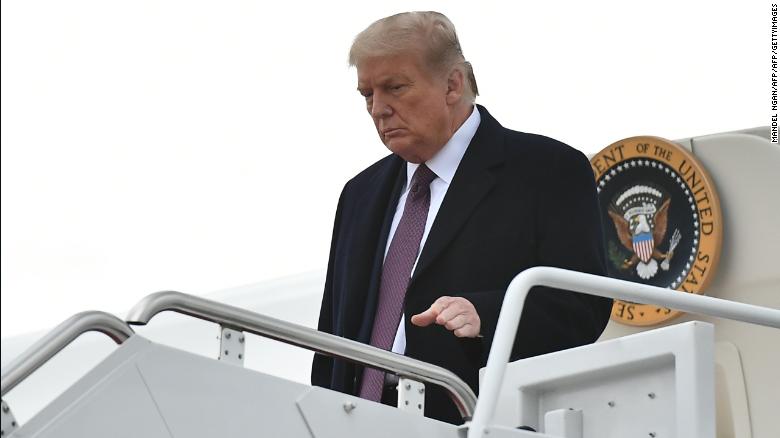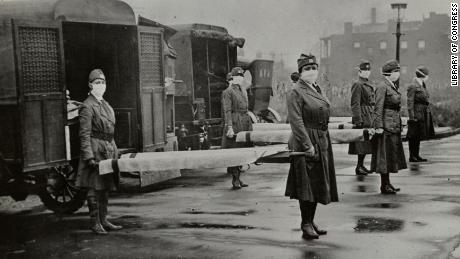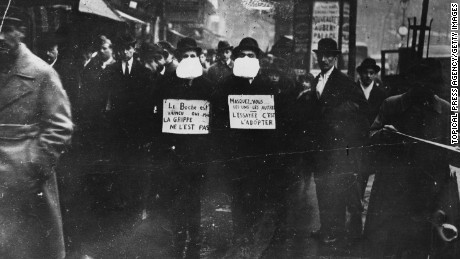(CNN)A century ago, a new respiratory virus gripped the country at the height of World War I. It started among American troops and exploded into a flu pandemic that killed 675,000 people in the US.
Like the coronavirus, the fast-spreading 1918 flu disrupted life in unprecedented ways. It overwhelmed health care systems, cleared public spaces, and shuttered workplaces and social events.
Like President Donald Trump, President Woodrow Wilson's administration downplayed the pandemic. And like Trump, who announced early Friday that he has coronavirus, Wilson also got infected. So did some of their closest aides and staff members.
"Wilson never made a public statement about the pandemic. Never," said John M. Barry, author of "The Great Influenza: The Story of the Deadliest Pandemic in History."
"So to keep morale up during the war, the government lied," Barry added, in an interview with CNN. "National public health leaders said things like, 'This is ordinary influenza by another name.' They tried to minimize it. As a result, more people died than would have otherwise."
Wilson already had one domestic crisis -- a world war -- to worry about, making the pandemic an afterthought.
"He had an OCD personality and he focused intensely on the war, period," Barry said. "Nothing distracted him."
But Howard Markel, a physician and medical historian at the University of Michigan, disagrees that Wilson downplayed the pandemic. The federal government was so small in that era, he said, it had a limited role in public health.
At the time, there were no federal health agencies such as the Centers for Disease Control and Prevention or the National Institutes of Health. The government's role was limited to war, collecting taxes, and making federal law, Markel told CNN. Local governments played a key role in health issues.
Wilson's administration kept his illness a secret
Trump's Covid-19 diagnosis is an extraordinary development a month before a presidential election. He has dismissed experts' guidance on wearing masks and holding socially distanced events even as the virus has killed more than 208,000 people nationwide.
At age 74 and obese, he falls into a high-risk category for serious complications from the disease.
Wilson was not exactly a picture of health when he got the flu at age 63. Before his illness, he'd suffered several health problems, including asthma and a stroke. He got the flu in 1919 while in Paris, where he spent several months negotiating the peace treaty after the war.
Wilson became ill and coughed so severely his doctor initially thought he'd been poisoned in an assassination attempt. He started having hallucinations that he was surrounded by spies. But his administration kept his illness a secret. There were no televisions and no social media back then so it did not take much effort.
"He thought the French were spying on him. He also believed he was personally responsible for things like all the furniture (in his room)," Barry said. "If he weren't President, deathly ill in the middle of the peace conference, it might have been funny."
After his recovery and return to the US, Wilson went on a national tour to drum up support for his peace treaty. He suffered a stroke later that year and died in 1924.
The 1918 flu mostly killed young people
While last century's pandemic -- it was often called the "Spanish flu," even though it didn't originate in Spain -- had some similarities to the coronavirus, there were some differences.
With the flu, people had horrific symptoms like bleeding from the nose, mouth, eyes and ears. The 1918 virus also mostly killed the young, which left researchers puzzled. The mortality rate was especially high in people between ages 20-40 and in children under 5.
"Roughly two-thirds of the deaths were age 18-50, and the peak age for death was 28," Barry said. "Soldiers were, of course, in the age group that was the prime target. The US military training camps obviously had high mortality."
Fear swept over the nation as people started turning on one another.
"Because they could not trust what they were being told, real terror gripped some people, so much so that society itself began to fray and it became everyone for himself," Barry added. "That's different from most disasters, when people come together to help each other."
Masks were an issue then, too
This will sound familiar. In 1918, public health authorities strongly recommended that people wear face masks to stop the spread of the virus. They also issued social distancing guidelines and urged people to practice proper hygiene.
But back then, Americans who did not wear masks were not making a political statement.
"Lots of people grumbled about wearing masks, or even refused to do so, but they weren't doing so because of a political stance or partisan allegiance," said Alexander Navarro, assistant director of the Center for the History of Medicine at the University of Michigan.
With the country at war, wearing masks was seen as patriotic. People who didn't wear them were shamed in public service announcements and news headlines for their defiance.
"Lots of elected officials as well as public health officers were telling people to wear masks as part of their civic duty," Navarro told CNN. "They were trying to tap into this idea that if you couldn't be over there fighting alongside our boys overseas, you could be doing your part here on the home front."
The flu faded in 1920 after killing more than 50 million people worldwide. There has been no flu as lethal before or since.








